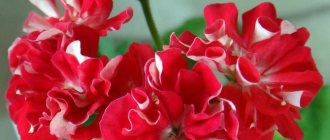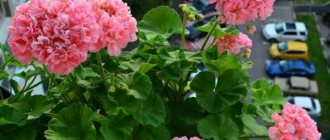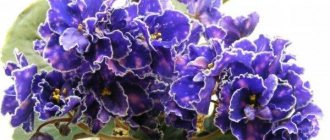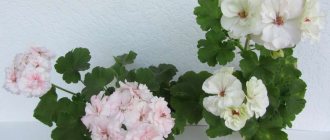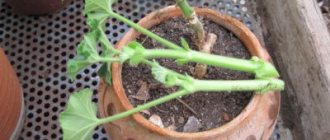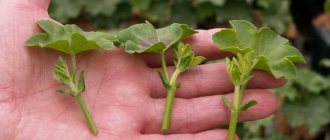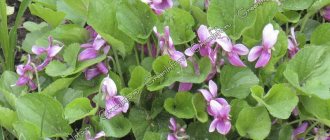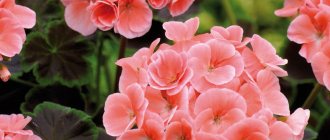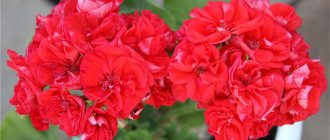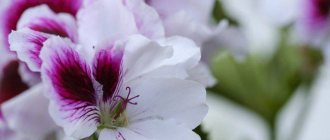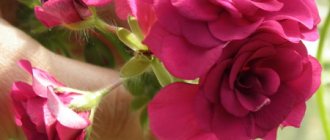The history of the appearance of the pelargonium variety Elnarids
Pelargonium was first discovered in the wild in Africa and southern Asia. Then it quickly spread across all continents, and came to Europe in the 17th century. Later, thanks to the efforts of breeders, different types of flowers were bred. Many of them began to be grown as ornamental plants.
This is interesting! Pelargonium and geranium are often confused. You can distinguish them by their bud. Geranium has 5 identical petals. Pelargonium has 2 upper and 3 lower ones, differing from each other in size and shape.
Video “Choice of variety and propagation of pelargonium”
From this video you will learn how to choose the right pelargonium variety and propagate the plant.
List of cuttings for April 23: Apricot Queen (ivy) - 350 rub. Reservation! It will still be. Barnstone-dale (ivy) - 300 rub. Baby Bird's Egg — 300 rub. Reservation! Belle d'Vain — 300 rub. Expand text… Blekinge — 300 rub. Reservation! Brookside Polka - 300 rub. Bold Carmine — 250 rub. Bold Gold - 350 rub. Bornholmpelargon - 300 rub. Bronze Butterfly (stellar) - 250 rub. Butterfly Lorelie — 350 rub. (Reservation!) Claire - 350 rub. Dagmar Murray - 400 rub. Diemierii Schafferi — 300 rub. Dovepoint - 300 rub. Edwards Courtney - 350 rub. Reservation! Edwards toscana - 400 rub. Elnaryds Ljuvliga Julia — 400 rub. Ekeby Lovisa — 300 rub. Elnaryds Karin — 400 rub. Elnaryds Secret Love — 300 rub. Elnaryds Singoalla — 350 rub. Elnaryds Shiva — 300 rub. Reservation! Elmfield (stellar) - 300 rub. Era's Silva (carnation flower) - 350 rub. (teenager) Fée Cerise Polina - 450 rub. Reservation! Jägershus Mormor Märta — 350 rub. Happiness - 350 rub. Harstena — 300 rub. Karen - 300 rub. Karl Hagele - 350 rub. Lilian Andrea (tulip) - 700 rub.
Description of varieties
Among the varieties of pelargonium of the Elnaruds series, there are the most common ones.
Hilda
Compact pelargonium with lush double buds of uneven pink and white color. The leaves are yellow with a brown spot in the middle. Hilda tolerates heat well and has a long flowering period.
Gusten
A vigorously flowering variety of pelargonium Elnaryds. The inflorescences are dense, the buds are peachy-pink. The bush has a compact shape.
Bente
Zonal pelargonium. It reaches a height of 10 cm. The inflorescences are lush and double. The buds are apricot-red. Flowering of this species begins in May and continues until the end of September.
Bente flower
Otto is often used to decorate balconies and verandas. The buds of this variety are orange in color, gradually turning into soft pink. The bush reaches a height of 10 cm. Flowering begins in late spring.
A variety of flower called Otto
Singoalla
House plant with white, slightly pinkish flowers. The bush is compact and easy to shape.
Lilian
A dwarf plant with double voluminous inflorescences. The buds can be bluish-lavender in spring and pink in summer.
Representative of the Lilian variety
Clarissa
Lush bush with snow-white double flowers. The plant is compact and does not require formation.
Clarissa flower
The best varieties
As already mentioned, zonal pelargonium has more than three hundred species. The most common are:
- Calliope Dark Red is a recently developed hybrid. The authors of this variety in the description always indicate the magnificent appearance of Calliope Dark Red - rich red double buds are located on a medium-sized bush;
- another medium-sized variety, Rafaella, differs from Calliope Dark Red in larger inflorescences and a variety of shades - from pale pink to lilac;
- Chandelier Violet blooms with purple buds from May to October. This variety is suitable for both outdoors and indoors, and with proper care it will delight you with large inflorescences sitting on bright green stems;
- pelargoniums of the PAC group (known in our country as PAK) are more expensive hybrids. Most of them were bred in the last two decades. PAK varieties are distinguished by a wide variety of colors and shapes - flowers similar to roses and classic geraniums, white, blue and all shades of red. In our country, the most famous geranium hybrids are under the following names - PAC Fireworks Red, PAC Fireworks Red-White, PAC Salmon Princess, PAC Viktor Improved. , PAC Viva Carolina (PAC Viva Carolina);
- The incredibly beautiful hybrid Red Pandora belongs to the tulip-shaped varieties. Red Pandora inflorescences resemble a set of small tulips of a soft scarlet color. The variety blooms for a long time and does not require serious care;
- pelargonium Montevideo grows into huge peony-shaped buds of a delicate salmon color. The plant is medium-sized and suitable for growing in an apartment;
- Unicorn Zonartic Rose is a vigorous growing species obtained by crossing the flowers of the golden variety Lara Zonartic and the purple variety Lara Suzanne. The result was a plant with soft purple petals and large double leaves;
- Another group of pelargoniums is Deacons. In this group there are plants of various shades - platinum, orange, white, burgundy and others. The flowers are short, with sparse foliage. A number of varieties are bred in Italian Tuscany (Kato, Claudio, Eric, Bernd), while others (Cupid, Emma Housley) are native to other European countries.
Reproduction
Pelargonium reproduces by seeds. They are planted in boxes with peat and left in a room with an air temperature of no more than +20 °C. The first shoots should appear in 3 weeks. All this time, the seedlings need to be irrigated with water from a spray bottle.
Important! The sprouts are moved to separate pots in early May. They need to be buried 4 cm into the ground and watered.
Basic flower care procedures:
- After planting in the ground, the plant needs to be watered several times a week. Do not over-water the soil or allow it to dry out.
- During the growing season, the flower must be fed with fertilizers containing nitrogen, potassium and phosphorus. However, you should not do this more than twice a month.
- Many types of pelargonium require formative pruning. To do this, the leaves are pinched so that the bush grows wider.
- In summer, the flower can be taken out into the fresh air and placed in places protected from direct sunlight.
- In winter, it is better to keep the plant in a place with a temperature of at least +20 °C. At this time, you need to water it no more than twice a month.
- It is recommended to replant pelargonium once every three years. The procedure must be performed in April or March so that the flower has time to take root by June and begin to bloom.
Features and care at home
A characteristic feature of zonal geranium is a colored border in the form of a dark spot along the edges of a round leaf.
May be dark green, dark brown or yellowish in color. In another way, the variety of colors on the leaves is called variegation.
The second important feature of geranium is its strong tart smell. And both flowers and foliage smell
Advantages
Zonal geranium is one of the most unpretentious and hardy representatives of the plant world.
- Disinfects indoor air.
- The healing properties of essential oils are used in medicine in the treatment of insomnia, neuroses, hypertension and other diseases.
- Geranium essential oils are used in the cosmetic industry.
- Long and lush flowering from early spring to late autumn.
Landing
Proper planting is the key to proper cultivation of crops both at home and outdoors. This beauty is planted as an ornament in flower beds, borders, on balcony boxes, for portable containers, for all types of flower beds and simply in large pots.
- The right choice of location is necessary. Geranium loves light, grows well and blooms when exposed to direct sunlight, especially in open ground; when shaded, the flowering is less lush.
- The soil composition should include humus, peat, leaf and turf soil. You can add sand for better moisture permeability. At the bottom of the pot, drainage from small pebbles or river pebbles is required.
- Properly selected container. You cannot plant in large pots, otherwise the geranium simply will not bloom. The roots should fill the entire space of the container. The size of the pot depends on the root ball of the plant, the diameter should not be more than 15 cm, the height should not exceed 12 cm.
- Landing technique. It is carried out in a transshipment manner together with a lump of earth on the roots for less trauma to the plant. Then you need to water. When planting seedlings, the distance between the bushes should be about 25 cm.
They are planted in open ground after May 15, when the threat of frost has passed. You can take it out onto balconies earlier.
Watering
Water should be abundant, but not excessive. When overmoistened, the roots begin to rot and the geranium may die, especially in winter. The soil should dry out between waterings. When planting outdoors, constant watering is only necessary for young plants or during long dry weather.
Fertilizer
For rapid growth of green mass and awakening of buds after winter, nitrogen fertilizer is necessary. Starting in April, fertilizing with phosphorus-potassium fertilizer is required for favorable flowering of zonal geranium. In winter, fertilizing is not used. In flowerbeds, plants are fertilized every 10-12 days until mid-August, and on balconies once a week.
Trimming
Zonal geranium is pruned twice a year. For the first time after winter, with the appearance of the first rays of sunlight, shoots are cut to further stimulate flowering, leaving 2 to 5 buds. The main pruning is autumn, necessary for better bushiness, carried out in late September-early October. In the fall, cut out old, unnecessary shoots and pinch out the apical buds.
Trimming can only be done to ⅓ or ⅔ of the height of the geranium. Pruning should only be done with a sharp, disinfected blade at an angle. The cut area is sprinkled with coal.
There are two ways to propagate zonal geranium:
- Vegetative—cuttings and leaves.
- Seeds.
Cuttings
It is the easiest and fastest way to reproduce. After spring-autumn pruning, you need to leave strong, strong cuttings without flowers, 10-15 cm in size, without uneven ends of the stem with two or three leaves.
- First, the cut must be dried a little, then placed in water until a thickening is obtained at the end of the stem.
- Rooting occurs quickly, this process takes 5-10 days, after which we transplant it into the ground into a small-diameter pot with drainage, water it as needed, protect the young sprout from the bright sun. You can also root the cutting in a peat tablet, without watering until geranium will not take root.
- It is advisable to lightly rub the seeds with sandpaper for better germination.
- Soak for 3 hours in any growth stimulator, then in plain water for several hours.
- Sow in a container with moistened special soil for geranium plants; drainage must be placed at the bottom. You can plant with a toothpick at a distance of 5 cm from each other, without digging too much.
- The container is covered with film and placed in a warm, well-lit place at a temperature of 20-22 degrees.
- Shoots appear after two weeks, after which the temperature can be slightly lowered.
- Seedlings are picked after 3-4 leaves appear.
Diseases and pests
Pelargonium has high immunity, so pests and diseases rarely bother it. But if not properly cared for, problems can still arise.
Blooming Pelargonium Hilda
If the plant is in the wrong place or has an incorrect watering schedule, this is indicated by the following signs:
- lack of flowering;
- rusty or dried leaves;
- rotting of the root system.
It is necessary to immediately eliminate the cause of the disease and treat the plant with fungicides.
In some cases, aphids, mealybugs or whiteflies may appear on the bush. When they are detected, the flower is sprayed with insecticides.
With proper care, pelargonium will become an excellent ornamental plant with bright, unusual flowers.
Pelargoniums
Pelargoniums, grown teenage cuttings in pots of diameter 9 at the Head on March 4 from 18.00-19.00 (often I arrive much earlier). Plants can also be picked up at Kievskaya on March 4 at 14.00 or at Paveletsky at 7.50. Dark, with glasses, turquoise scarf. I will be from 18.00 to 19.00 (usually I arrive earlier) at the wall as close as possible to the doors of the toilet, which is next to the bust (I will warn the girls in the middle of the stairs where I am standing). Closer to the trip, additions are possible. If necessary, I will send photos of the cuttings to your email. The plants are all in pots, grown, some are already blooming or thriving. For any questions, you can write to the phone 8 960 120 12 22.
I accept orders until 12.00 March 3
SOUTH Princess Grace 3000, 3500 very large cuttings Leona Snow Carousel 500 Silk Elegy 300 Grandeur Deco Caramel Pink 350 beautiful leaves, double flowers Grandeur Deco Caramel Violett 350 beautiful leaves, double flowers reservation
Planting a flower
The optimal time to plant a plant is spring, when the growing season has just begun. Before planting in the soil, you must add complex mineral fertilizers.
- Fill the bottom of the pot with drainage, then some soil.
- Place the plant in a pot.
- Fill with the second part of the soil.
- Compact the soil and then add some more soil.
Planting ends with abundant watering of the flower with warm water that has been standing for two days.
Important! The soil should be neutral or slightly acidic.
Plant care
In order for pelargonium to bloom profusely and not get sick, it needs to be looked after regularly.
- Watering should be regular and moderate. It is advisable to use water that has stood for two days.
- During the growing season, fertilizing is applied to the soil. Mineral fertilizers are suitable for flowering crops. Wood ash is used from organic matter.
- Organize proper lighting. The flower prefers diffused light. It is recommended to place pots on western windows.
- After flowering, the inflorescences are cut off. You also need to immediately pick off dry and yellowed leaves.
Overall, geraniums are easy to care for.
The plant needs to be watered regularly
Competition “The most abundantly flowering pelargonium”
Moderator: Floriana
Competition “The most abundantly flowering pelargonium”
Post by Nimfea » Mar 27, 2016, 9:43 pm
Let's resume this competition.
Competition “The most abundantly flowering pelargonium”
Participants in the competition must show a full-length photo of a blooming pelargonium so that you can see the size of the plant and the number of flowers on it. So, take pictures of your favorites in spring and summer! The plant can be indoor, balcony, garden, the main thing is that it is taken in a neat condition and there should be no clutter in the background. The photo and plant must be yours. If you know the name of the variety, then sign for a better search on the web for our competition.
The competition will last from March 28 to September 15, 2016. All competition participants will receive a prize - a virtual medal for participating in the competition.
Competition “The most abundantly flowering pelargonium”
Post by Galina55 » March 29, 2016, 10:20
I have the most profusely blooming Brookside Rosa.
Competition “The most abundantly flowering pelargonium”
Post by Callirya » Apr 01, 2016, 00:02
Competition “The most abundantly flowering pelargonium”
Post by Bagiro4ka » April 16, 2016, 8:30 pm
Barnstone Dale ampelous ivy leaf. From spring to October everything is in flowers.
Competition “The most abundantly flowering pelargonium”
Posted by mirioran » April 16, 2016, 9:19 pm
Reproduction
The easiest way to propagate is by cuttings. Cuttings are cut in summer or winter. For planting, select healthy apical cuttings with 3-4 leaves. They are cut at an angle of 45 degrees.
Before planting the cutting, the cut site is treated with charcoal for disinfection. After this, the future bush is planted in the ground and covered with a cut bottle. This will create greenhouse conditions so that the sprout takes root faster.
Important! Once a day, remove the bottle for 10 minutes.
The main thing is not to forget to water the cuttings. In about 4-5 weeks, rooting will be complete.
Diseases and pests, combating them
- Gray rot. For treatment, the bush is transplanted into new soil, the damaged parts of the roots are cut off before this. The sections are treated with a solution of potassium permanganate.
- Verticillium wilt can be stopped by treating the bush with Fundazol or Vitaros.
- It is best to remove aphids by spraying with a solution of regular soap.
- Treatment with acaricidal preparations saves the bush from spider mites.
Important! In order to avoid having to deal with pests and diseases, you need to carefully care for the flower.
Pelargonium is a beautiful and unpretentious plant, which can be called one of the favorites of most gardeners.
Pelargonium Elnaryds Hilda and other varieties of the Elnaruds series
Pelargonium is one of those plants that are indispensable in the design of home interiors and garden plots. Thanks to the wide variety of varieties, the crop is gaining more and more popularity.
Description of pelargonium varieties of the Elnaryds series
Nothing is known about the origins of Elnaryds. However, the description of popular geranium varieties from this series is worth studying in order to choose the most suitable one for yourself.
Hilda
Pelargonium Elnaryds Hilda is a dwarf variety. The petals are white in the center, turning salmon color towards the edges. Double flowers.
Gusten
Pelargonium Elnaryds Gusten is distinguished by double inflorescences. The flowers are light peach in color. The bush is compact.
Bente
The Bente hybrid grows up to 10-12 cm in height. The inflorescences are double, the shade of the petals is soft apricot turning into a rich red color.
The Otto variety is distinguished by orange-pink double-type inflorescences. Belongs to the dwarf varieties.
Singoalla
The Singoalla variety is characterized by double white flowers collected in spherical inflorescences.
Lilian
The Lilian variety is characterized by lush inflorescences collected from double flowers. Petals are pale pink.
Clarissa
The Clarissa variety is distinguished by double and semi-double flowers collected in spherical inflorescences. Petals are white.
Variety Elnardis Clarissa
Planting a flower
The optimal time to plant a plant is spring, when the growing season has just begun. Before planting in the soil, you must add complex mineral fertilizers.
- Fill the bottom of the pot with drainage, then some soil.
- Place the plant in a pot.
- Fill with the second part of the soil.
- Compact the soil and then add some more soil.
Planting ends with abundant watering of the flower with warm water that has been standing for two days.
Important! The soil should be neutral or slightly acidic.
Plant care
In order for pelargonium to bloom profusely and not get sick, it needs to be looked after regularly.
- Watering should be regular and moderate. It is advisable to use water that has stood for two days.
- During the growing season, fertilizing is applied to the soil. Mineral fertilizers are suitable for flowering crops. Wood ash is used from organic matter.
- Organize proper lighting. The flower prefers diffused light. It is recommended to place pots on western windows.
- After flowering, the inflorescences are cut off. You also need to immediately pick off dry and yellowed leaves.
Overall, geraniums are easy to care for.
The plant needs to be watered regularly
Reproduction
The easiest way to propagate is by cuttings. Cuttings are cut in summer or winter. For planting, select healthy apical cuttings with 3-4 leaves. They are cut at an angle of 45 degrees.
Before planting the cutting, the cut site is treated with charcoal for disinfection. After this, the future bush is planted in the ground and covered with a cut bottle. This will create greenhouse conditions so that the sprout takes root faster.
Important! Once a day, remove the bottle for 10 minutes.
The main thing is not to forget to water the cuttings. In about 4-5 weeks, rooting will be complete.
Diseases and pests, combating them
- Gray rot. For treatment, the bush is transplanted into new soil, the damaged parts of the roots are cut off before this. The sections are treated with a solution of potassium permanganate.
- Verticillium wilt can be stopped by treating the bush with Fundazol or Vitaros.
- It is best to remove aphids by spraying with a solution of regular soap.
- Treatment with acaricidal preparations saves the bush from spider mites.
Important! In order to avoid having to deal with pests and diseases, you need to carefully care for the flower.
Pelargonium is a beautiful and unpretentious plant, which can be called one of the favorites of most gardeners.
Pelargonium Elnaryds: description and cultivation
- Peculiarities
- Kinds
- Landing
- Care
Among the variety of ornamental geranium plants, pelargonium occupies a leading place. It is loved by many gardeners for its short stature, curly and lush bushes, abundantly dotted with buds, as well as for its long flowering period. This herbaceous crop will be discussed in the article.
Peculiarities
This flowering plant was first discovered on the African continent and in the southern regions of Asia. Later it began to be grown in different countries of the globe.
The culture is endowed with stems that can either creep along the ground or stand upright. The stems themselves are short, for this reason pelargonium is classified as a genus of dwarf plants.
The leaves come in a variety of shapes. They are:
- ordinary and feathery elements;
- leaves that are rough to the touch and look like fingers.
The flower stalks grow in the shape of a ball, they are very thick and lush. Pelargonium flowers are small, the petals are divided into double, simple, and come in a curved configuration. The plant contains a number of essential oils, due to which it is endowed with a bright citrus aroma. It has a fairly wide range of colors. The buds can be soft pink and have rich shades such as coral tones. Pelargonium is grown in pots, flowerpots, containers, cache-pots and other containers.
You can decorate your garden, terrace or balcony with pelargonium, provided that at the slightest drop in air temperature to +5.7 degrees Celsius, the flowers will be transferred to a warm room. Usually, pelargonium is planted in flowerpots outside. It does not withstand drafts and gusty winds.
If your flower grows at home, then select rooms for it that face the south side with good lighting.
Breeders have developed a large number of different varieties and hybrids of the plant. Pelargonium is divided into groups.
- Zonal. It includes up to hundreds of tall and dwarf bushes. Among decorative flowers, pelargonium Elnaryds Alexis is considered the most popular.
- Royal . It has a tall stem, with dense bushes with double and semi-double peduncles concentrated on it.
- The crop may be an ivy-leaved plant. It got its name from the peculiar shape of the leaves, similar to ivy, and the long stems flowing down the sides of the container in which the flower is planted. The inflorescences are lush and dense brushes.
- Pelargonium is also divided into succulent and fragrant crops.
Succulent species are characterized by thick, arching stems with small leaves and large flowers.
The dwarf group includes several dozen pelargoniums, popular among gardeners. These include: Annelie, Hilda, Otto, Bente, Gusten, Lilian, Olivia, Ebon, Ljuvliga, Julia, Jazz, Alizia, Pippi, Rasken, Clarissa, Lina, Lady Molly, Windcatcher, Maestro, One of a Kind and many other names.
History of the zonal species
Geranium of the genus Pelargonium zonalis was first discovered in the middle of the last millennium on the African continent. The plant attracted the discoverers with its bright flowers and unusual box shape. This shape resembled the beak of a stork, which is why the new species was given the name Pelargoniums - a derivative of the Greek "πελαργός", which means "stork". And the word “zonal” appeared in the name due to the special color of the leaf plate - in spring and summer a small zone appears on it, painted in a different color. Thus, the Latin name for zonal geranium was formed - Zonal pelargoniums.
For the first time, zonal pelargonium came to Europe from Africa in the 18th century - it was brought by British sailors to their homeland. There the flower gained wide popularity and until the beginning of the twentieth century remained a symbol not only of the Victorian era, but also of English bourgeois life in general. At the time when the popularity of the plant in the British Isles began to decline, zonal geranium was already known throughout Eurasia, thanks to which its old varieties were actively bred and new ones were developed.
To date, more than 350 varieties of Zonal pelargoniums are known. The flower is grown both indoors and outdoors, and the variety of colors allows you to choose a crop option to suit every taste.
Landing
Since the crop is mainly dwarf, the pots for planting should be purchased small so that the main emphasis during the growth of the plant is not on its root part, but on the shoot located above the ground. The land for planting should contain some sand and peat.
Seeds are planted in peat boxes. The seedlings should be kept in a room with an air temperature not exceeding +20 degrees Celsius. Typically, sprouts appear 21 days after planting. During the entire period, watering must be done by irrigation from a sprayer.
Seedlings that have grown by summer require planting in the ground in early May. It is recommended to bury them into the soil no more than 40 mm. The planted shoot must be lightly compacted with your fingers and then watered.
After planting the plant, it must be watered once every 2-3 days. The soil should not be too wet, but it should not be too dry.
The soil needs to be fertilized periodically. Flower shops sell formulations containing nitrogen, potassium and phosphorus. They should be fed to the plant during its growing season, but not more often than 2 times a month.
When a sufficient number of leaves and flowers have formed on the bushes, you can form a “cap” from the peduncle, pinch the leaves so that the bush grows in width and has an elegant, lush peduncle.
In summer, pelargonium should receive the maximum amount of fresh air for good growth. It is recommended to take it out onto balconies, terraces, into the garden under trees, in places protected from direct sunlight. The flower tolerates temperatures above +25 degrees Celsius reluctantly.
In winter, it is recommended to keep pelargonium bushes in cool rooms with a temperature not exceeding +13 degrees Celsius. At this time of year, you need to water the crop no more than twice a month.
A flower is transplanted once every 3 years. This is done in the spring, at the end of March or in April. By June, the plant takes root in a new place, blooms and delights with its beautiful buds all summer.
To learn how to grow pelargonium, see the following video.
What care needs to be provided to bloom magnificently: step-by-step instructions
Next, we will explain how to properly care for ampelous geraniums at home. Before you plant ampelous pelargonium or bring it from the store, you need to choose a place. This flower culture loves good lighting and is not afraid of direct sunlight.
The most suitable windows are on the south and southeast sides. In the yard, pots with ivy-leaved pelargonium are placed in open areas.
Proper landing
You can plant a cutting or a separated part of a bush. The right time is spring. During flowering, replanting is not recommended. You can also replant in the fall. Pelargonium takes root well, the main thing is to prepare suitable soil.
Soil composition:
- 2 parts of turf land;
- 1 part sand;
- 1 part peat.
Additionally, you can add a little clay and coal, crushed into powder. All components are mixed, the soil is spilled with a solution of potassium permanganate, boiling water or calcined in the oven. A small layer of expanded clay is placed at the bottom of the container - it will act as drainage.
How much should I plant?
The smaller the pot, the more magnificent the flowering. The optimal diameter for one plant is 10-14 cm. When replanting, take a container with a diameter 2-3 cm larger. When the bush reaches such a size that it requires a pot larger than 14 cm in diameter, division is performed. Each learned specimen is replanted in a small pot.
How to water and what to feed?
The need for moisture is determined by the top layer of soil: when it is slightly dry, it is time to water. Do not allow the earthen clod to dry out and water to stagnate on the soil surface.
In summer they water more often, in winter - less often. There is no need to spray the plant, otherwise the leaves will rot. At any time of the year, the ampelous geranium is ventilated, but so that there are no drafts.
Feeding begins in early spring and stops at the end of summer. The frequency of fertilization is once every 10-14 days.
The regularity and composition of fertilizing affects the quality and duration of flowering.
When ampelous geranium just begins to grow, it needs nitrogen to form green mass. Bud formation and flowering are periods when the plant requires phosphorus and potassium.
It is better to feed with ready-made fertilizers for ampelous pelargonium: the components in them are selected in the correct proportion. Purchased products alternate with homemade ones. For example, you can water:
With diluted milk. Infusion of onion peel. Settled water with added iodine (1 drop per 50 ml)
Carefully water the soil with iodine solution closer to the edge of the pot.
Is pruning necessary and how to do it?
Removing excess shoots is necessary to rejuvenate, improve the health of the bush and make it decorative. Without formation, the plant gradually becomes less attractive. The right time for pruning is late autumn, when the bush has flowered and is preparing for winter.
If you leave the plant to overwinter along with all the leaves, fewer inflorescences will form in the spring than it could. Perform deep pruning: shorten the shoots growing from the leaf axils, leaving 7 leaves on each. The branches grown from the roots are left untouched.
Runs that grow from the crown are removed if they are dried out, weak or diseased. During the winter, the geranium can fluff up and grow, then in the spring it is pruned again. At the same time, excess shoots are removed, leaving enough buds so that the plant can form a lush bush.
During spring, the bush is formed by pinching. Remove part of the shoot after the fifth leaf. This procedure is done regularly.
